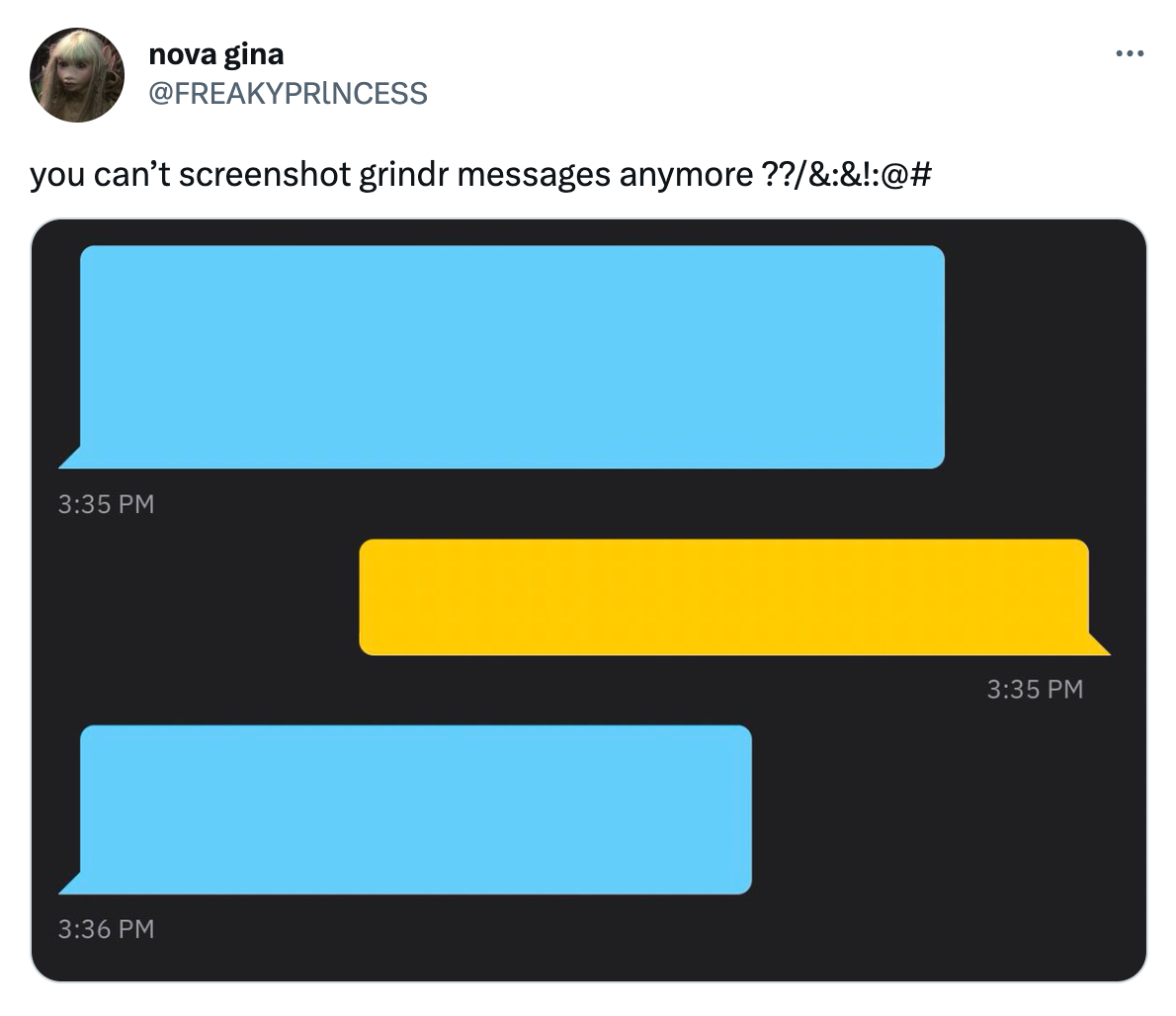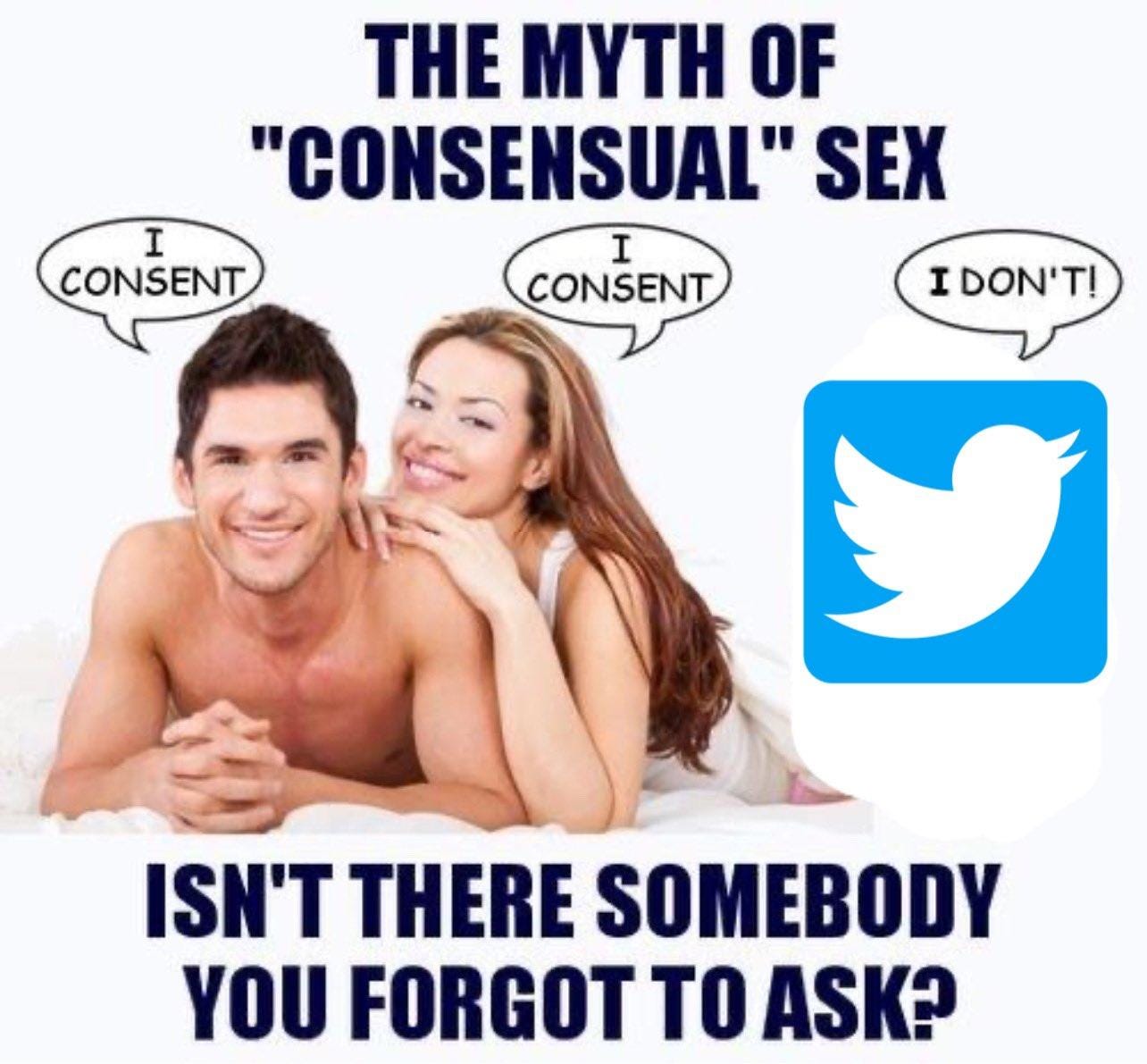Dating as a Digital Performance
On using dating apps for content and the Internet as the third party in our relationships.
Hello and welcome to Many Such Cases.
I heard via tweet this week that Grindr has begun blocking screenshots of conversations within the app. Is it real? Probably not. Like most the screenshots of actual text conversations that make it to Twitter, this too is probably just bait designed for engagement. But wouldn’t it be nice? Wouldn’t it be nice for not just Grindr, but for all the other dating apps to prohibit us from making content out of what ought to be a bit more of a personal pursuit? Can we imagine the dating world getting back to normal any other way?
We’ve long afforded certain people to mine their lives for art, writing, media, what have you. Many of us, in wanting to be more like those real and fictional figures like Anaïs Nin or Carrie Bradshaw who have transformed their experiences into something for public consumption, have more quietly done the same. We do things for the plot, to tell our friends a funny story, to write about in our journal, to look back upon when we’re older. That’s a good thing. It enriches our lives to have experiences for the sake of experiences. What’s happened more recently, however, is that many of us have confused “having an experience” with “writing a tweet.”
Over the weekend, a new swarm of sticky discourse was set off by a young woman tweeting a screenshot of a conversation between her and a man on Hinge. On her profile, she wrote that she prefers when a man suggests a specific date, time and location for their first date — good advice for most to follow, generally. When he messaged her with the suggestion of a bar in East Williamsburg (FourFiveSix, if you’re familiar) at 7:30 this week, she responded by saying she was sure this must have been a bar by his apartment and that he had no consideration of the fact that she lives in Manhattan.
“he really thought he ate that,” she wrote in the tweet. “F for effort in asking me to travel an hour to have a drink with you at a place 2 blocks from your home. drinks is so he can spend less money but it’s nighttime so he can ask me back to his place after. & as if Manhattan doesn’t have patios?!”
She is not entirely wrong here in being turned off by his proposal. She would likely need to take two trains and it’s perfectly fair to prefer you do dinner as a first date. Choosing a location that is central to both of you is polite. It’s fine that she doesn’t want to go out with this guy, and it’s fine that other people might find his prospective plans perfectly acceptable.
What turns me off about the whole exchange, however, is that I’ve been made to bear witness to it at all. Not every perceived slight warrants an entire viral tweet. But this is the dynamic we currently exist in: we’re dating not to date, but for content. And not even life content, if you want to grossly call the totality of your memories content, but merely flat social media content. And this woman, specifically, is a “content creator” by her own identification. She has nearly 500,000 followers on TikTok. She shapes the presentation of her life around “what I spent in a week” or “what I eat in a day” videos. It’s fair to assume that she approaches dating apps much in the same way, considering what would make for an interesting post.
On a far smaller scale, I suspect this perspective has become something of the norm. At very least, it’s another addition to the list of reasons why dating apps haven’t fulfilled the promise of better connecting people. Even if you aren’t consciously thinking of how your dating app encounters would translate on social media or would never think of posting screenshots of relatively benign conversations for public critique, you may still be functioning on dating apps as though you are part of this discourse just the same. And sure, this type of self-surveillance is part of what helps us act like normal people, what helps deter bad actors from leaning into their worst behaviors. We ought to present ourselves in a way that reflects how we want the world to look at us. But what comes of that when the world we’re considering is really just one on Twitter? Are we presenting the best, most authentic versions of ourselves when we’re semi-consciously curating our image with the knowledge that it could be screenshotted and posted on social media?
Rather than a means to an end, the dating app becomes the end unto itself. And everyone knows they suck! Nobody really wants to be on them! But we’re stuck in this moment where nobody really has a solid idea of how to find a date without their phones. We’re not even totally sure who we are without our phones — everything is done with some consideration of how it would translate digitally. The original post could have been shared with some intention of highlighting to men how they can better consider the needs and circumstances of their date before suggesting a location, or to emphasize to women that they should be more selective in their dates out of respect for their own time and money. But even if it was shared with the best of intentions, it immediately dissolved into a back-and-forth on Twitter about the train system, what qualifies as a nice bar patio, whether it’s even safe to go on a date with someone near their apartment, what the purpose of living in New York City is at all. And the undertone to all of it, regardless of the actual subject, was that you better be as self-conscious about how you use dating apps as possible, lest you slip up and select the wrong bar for a first date and become the subject of this week’s hot Twitter narrative. You’d be reasonable to just want to give up on it.
It’s fun to pretend we’re Carrie Bradshaw. It’s maybe even good to rack up the experiences for our diaries to revisit later in life. It’s also perfectly okay to say no to a date because you don’t like the location the person selected. But the combination of these attitudes needn’t be shared for a public audience. The minutiae of our personal lives really isn’t worth sharing when we have nothing profound to attach to it, even if the algorithm suggests otherwise.
In related news, I am not quite sure what the relationship between Substack and Twitter continues to be. It sometimes looks as though links are working again despite Musk making them impossible to interact with last week, but even before then, links from Substack seemed to be deprioritized. It’s funny that I get so much of my writing fodder from Twitter and yet identify it as part of the problem in said writing. Hehe. But with the Twitter promotion issues in mind, now is a particularly good time to consider becoming a paid subscriber. I’m hustling here, baby!






